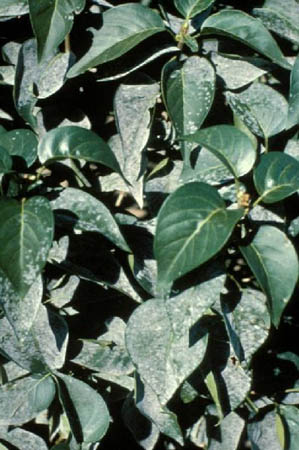Powdery Mildew | |
|---|---|
| July 18, 2006 | |
|
Powdery mildew is usually rather easy to diagnose. The disease causes a powdery, white layer on foliage, as you can see in this image of an infected lilac.  Most tree and shrub species can be infected, as can most annuals and perennials. There are literally hundreds of species of fungi that may cause powdery mildew on various hosts. Fortunately, most species have resistance, or they can host the disease without permanent damage. A few forms can be quite pesky or unattractive, such as powdery mildew on rose, zinnia, phlox, and lilac. The disease is probably more of a concern on fruit and vegetable crops that can lose yield as a result of infection. Most tree and shrub species can be infected, as can most annuals and perennials. There are literally hundreds of species of fungi that may cause powdery mildew on various hosts. Fortunately, most species have resistance, or they can host the disease without permanent damage. A few forms can be quite pesky or unattractive, such as powdery mildew on rose, zinnia, phlox, and lilac. The disease is probably more of a concern on fruit and vegetable crops that can lose yield as a result of infection.Unlike most fungal diseases, powdery mildew is not as destructive when rains are frequent. The six common genera of powdery mildew fungi in the Midwest all prefer warm, humid days. The spores germinate on foliage when the relative humidity is 23 to 99% but do not germinate in free moisture (rain). Recent saunalike conditions should promote this disease. There are many different types of powdery mildew fungi; and most are very host specific. For that reason, we will probably never see an epidemic of this disease in Illinois. Still, on one plant, the disease may spread very quickly, especially in humid weather. Despite the fact that this disease does not kill plants, if your zinnias, roses, or other plants are infected, that may be a major aesthetic concern to you. It can do a number on dogwood trees as well. Although most other powdery mildews in our landscape cause symptoms in mid-July, the powdery mildew fungi on dogwood are active all summer. We see symptoms starting much earlier on this species. Symptoms of powdery mildew include a white mildew type of growth on the leaves, shoots, buds, flowers, or stems. This mildew is composed of threadlike mycelium and asexual spores of the fungus, which are easily blown to other plant parts and cause further infection. New growth is particularly sensitive. The disease is usually very obvious and often unsightly. Occasionally, infected foliage exhibits a purple cast and rolling of leaves rather than a white color. This is true of infected apple or crabapple or as seen on these infected strawberry leaves.  To avoid problems with powdery mildew, provide conditions for adequate air flow in the planting. This may mean that plants need to be thinned or pruned to allow better air movement. Use recommended mature plant spacings when establishing new plants. Because the pathogen thrives in humid conditions, water the plants early in the day to promote rapid drying. Avoid syringing foliage, and try to water the soil rather than the foliage. Resistant varieties are the easiest means of disease control, but such plants are not always available. Fungicides are available to control the mildews, and if sprays are begun at the first sign of mildew, control can be attained. Scout for the appearance of the disease and then treat the plants according to label directions. If damage is minor, no action may be required. Consult the Commercial Landscape & Turfgrass Pest Management Handbook or the Home, Yard, & Garden Pest Guide for a list of registered fungicides by host and by disease. These manuals are available in your local Extension offices. Report on Plant Disease, no. 617, “Powdery Mildews of Ornamentals,” is available on the Extension Web site http://www.ag.uiuc.edu/%7Evista/horticul.htm or in Extension offices and provides detailed information about powdery mildew. | |
| Author: | Nancy Pataky |
